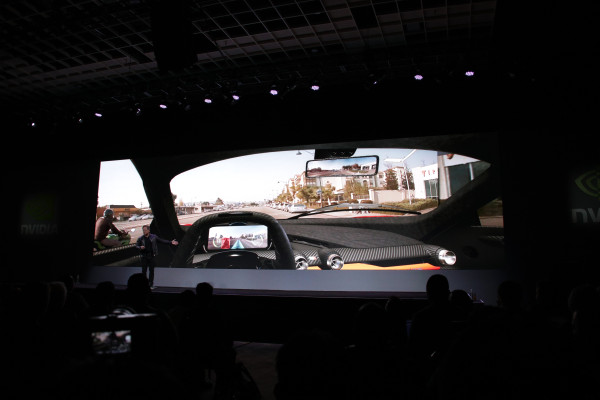
Nvidia has taken the AutoSIM virtual environment for testing autonomous cars it originally showed off at CES, combined it with its Drive Pegasus AI in-car computer and created a virtual testing and validation loop that can handle billions of virtual driving miles in hyperrealistic environments, with the ability to model edge cases and recreate conditions that would be difficult to test exhaustively on real roads.
The system designed for use by its partners is called Drive Constellation, and involves using two different servers to accurate simulate real-world autonomous driving in a totally virtualized enjoyment. One server runs Nvidia’s Drive Sim software, which will simulate an automated vehicles sensory experience while out on the road, providing photorealistic camera captures and data from virtualized LiDAR and radar systems that accurately mimics what would be captured driving on a real road.
The second server in the system is running an Nvidia Drive Pegasus AI, or the ‘brain’ of an autonomous vehicle, which processes the data fed from the first server just as it would if it was real data being fed from vehicles sensors capturing it from the road. The Pegasus-powered server then returns its control commands back to the simulator, telling it to carry out driving activity just as it would a real car on the road.
This is what Nvidia terms a “hardware-in-the-loop” cycle, and it can run at 30 such exchanges per second, helping to validate autonomous driving software performance. And because it can be fully controlled by the tester, the Drive Sim part of the equation can be tuned to provide a realistic driving experience like one might encounter on roads, or artificial conditions like enduring 24 hours of blinding, peak mid-day sun – or whatever edge case a researcher or developer might want to test and optimize for.
Edge cases remain the primary concern for anyone developing autonomous cars, and the issue with relying on real-world testing to build software that can properly handle these edge cases is that they don’t occur often, and they’re seldom replicable. Software simulation is a way to prepare for these rarely occurring instances without risk and without having to wait for conditions to align themselves just right (or wrong, as the case may be).
Nvidia’s Drive Constellation is going to start becoming available to some of its partners through early access during the third quarter of this year, and will roll out commercially sometime after that. Of course, Nvidia also announced today that it’s temporarily suspending its autonomous driving testing while it investigates the recent Uber self-driving car testing accident that resulted in a pedestrian death, but more testing in simulation should, in theory make for fewer potential accidents on real roads.


